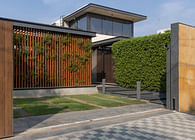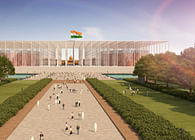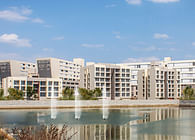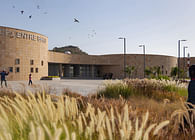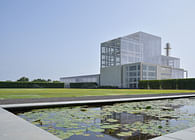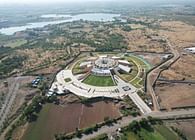
Ahmedabad, IN
India’s largest and first planned inland aquarium, the Aquatic Gallery is a 5th generation world-class public aquarium. It has been commissioned by the Gujarat Council of Science City, an autonomous registered society established under the Department of Science and Technology, Government of Gujarat. Catering to the vision of edutainment and designed with a vision to bridge the gap between formal science education and the community at large, it is a major attraction in the sprawling 200 acres Science City campus in Ahmedabad, which attracts more than 1 million people annually. Subsidized tours for schoolchildren enhance awareness of underwater life, and rural kids visit for free, thereby fulfilling a social responsibility to promote education and environmental consciousness. A major challenge was the project execution during COVID-19, which was met without any compromise on timelines, quality, & procurement of fishes across international borders.
With a form inspired by nature and natural forms – the spiraling, mysterious structure of the galaxy, and the perfectly proportioned shells found abundantly along Gujarat coast, it features an underwater viewing walkway, multi-level viewing gallery & interpretation centre. The circular, segmented and spiral organization of the viewing galleries, inspired by the nautilus, allows seamless movement through spaces of increasing size and continuity, creating a dynamic exterior form, with the central circular atrium providing a multipurpose space from where the galleries emanate; its form rises at the centre of the spiral, reaching upward for light through clerestory windows. The design evokes many environmental associations, the most important being a connection to water and life within. Visitors are treated to an engaging sensory experience, enhanced by well-integrated lighting, AV technology, projections, interactive features & environmental graphics.
A steel and glass canopy, resembling a cantilevered petal, amplifies the entrance's appeal. The central attraction is the 90-feet-diameter atrium, crowned with a steel deck slab supported by fabricated trusses, setting the stage for an extraordinary experience.This atrium features a monumental water-world map floor mural, showcasing oceans along with an orientation audio-visual show. The 72 exhibit tanks with huge 12x4m windows and interactive display screens, house 180 species. 12,000 fishes native to various regions are categorized into zones such as the Indian, Asian, African, American, etc. A major attraction is the Oceanarium with its 30m long transparent tunnel housing sharks and various species. Each tank is connected to life support systems (LSS) which maintain salinity, pH, & TDS levels, chemical oxygen, etc. Laboratories and quarantine areas facilitate regular checkup and testing. Touch pools, a penguin exhibit, a 5D theatre & a ship-themed cafeteria, all offer an interactive, immersive, and fun experience for kids and adults alike.
The exterior utilizes exposed green concrete, fly ash bricks, metal, and glass, harmonizing with natural shapes. Exposed RCC surfaces introduce a dynamic visual quality, including shadow interplays on the façade & openings resemble fish gills. The glass along the public and support areas allows natural daylight. Both form & detailing prioritize structural stability & resilience against seismic activities.
Efficiency is at the heart of the design, utilizing various strategies to curtail energy consumption. These include an insulated envelope and a high-performance glazing system with low emissivity. The structure is designed to be taller on the southern side, self-shading portions of the building at all times, & service areas along the perimeter insulate the aquariums from direct heat exposure, enhancing operational efficiency. Solar rooftop panels harness renewable energy. The atrium benefits from diffused natural light, through fritted glass north clerestories. The lower level houses the exhibits, enabling the majority of water loads to remain at ground level within a controlled environment, promoting stable water temperatures & optimal life support systems. The centralized Chilled Water Energy Efficient System with chillers, pumping systems equipped with Variable Frequency Drives (VFDs), & evaporative cooling for fresh air, collectively save 90 tons of cooling by employing domestic water evaporative cooling for fresh air circulation, translating to a substantial 24,000 USD/year savings. Integrated Building Management Systems (IBMS) compatibility is maintained through RS-485 equipped meters. Intelligent automation controls lighting, offering dimming, dim-out, & programmable options, significantly saving energy.
Aquariums of this scale involves a clutch of operative technology like foam & sand filters, ozone generators, and life support systems to provide the water quality, chemistry, biology, temperature, turnover and quantity required for each live inmate. The obviously excessive energy load required for these has been efficiently compensated by integrated energy efficient systems that reduce consumption by 30%. Economic feasibility and sustainability is addressed by collaborating with the local waste disposal facility to avoid incineration on site. Encouraging and providing research and breeding facilities addresses replacement costs as well as safe transportation of the species. A state-of the-art filtration system addresses the water recycling costs.
Since aquariums are complex structures that draw substantial crowds and demand consistent management, assistance, and amenities, the design incorporates a dual-faced approach—one catering to the public and the other to the support staff and maintenance. This ensures an optimal visitor experience while simultaneously providing an ideal habitat for the exhibits and uninterrupted upkeep.
The Aquatic Gallery shares a centralized sewage treatment plant with three other galleries, using energy efficient FMR (Fluidized Media Reactor) type of STP (Sewage Treatment plant) process. A centralized tank supplies water to the double-walled gallery tanks, from where it is distributed through Hydropneumatics pumping system. All Life Support Systems (LSS) for the tanks are supplied with fresh and salt water through the extensive water network. Specialized ZLD (Zero Liquid Discharge) system is used for Saltwater Reject, which is then received into waste collection sump and transferred to an evaporator for treatment. This treated water is reused for landscaping and reject water is transferred to slat water tank. Rainwater harvested from the roof is directed to recharging wells, further minimizing the water footprint. Efficient plumbing fixtures contribute to a 44% reduction in water consumption.
The Prime Minister of India, Narendra Modi, on a recent visit, said that the Aquatic Gallery is a celebration of aquatic biodiversity and marine marvels. "It highlights the delicate yet dynamic balance of our aquatic ecosystems. It is not only an educative experience, but also a call for conservation and deep respect for the world beneath the waves," he added.
Status: Built
Location: Ahmedabad, IN
Firm Role: Architecture, Interior, Landscape and MEPF Engineering
Additional Credits: Individuals:
Project Mentor/Director (Over all) - Ar. Jayesh Hariyani
Project Mentor - Ar. Adi Mistry
Project Director - Ar. Rakhi Rupani
Project Director - Ar. Saumil Mevada
Project Director (MEPF Eng.) - Er. Parth Joshi
Firms / Companies:
Prime Contractor - Shapoorji Pallonji E&C
Marine Contractor - Marinescape Limited
Consortium Member - Kling Consult GMBH
Interior/Exhibit Designer - INI Design Studio
MEPF Engineer - INI Infrastructure & Engineering
Life Support System - INI Infrastructure & Engineering
Landscape Architect - INI Design Studio
Structural Engineer - Ducon Consultant Pvt. Ltd.
AV/IT Engineering - T2 Technology Consulting Group
Exhibit Designer - Lemon Design





